Diabetic Foot Ulcer Treatment Market Research, 2032
The global diabetic foot ulcer treatment market size was valued at $4.4 billion in 2022, and is projected to reach $7.4 billion by 2032, growing at a CAGR of 5.4% from 2023 to 2032. Diabetic foot ulcers are the common complication of diabetes that may have severe effects if not properly treated and handled. They occur as a result of multiple factors, such as peripheral neuropathy, peripheral arterial disorder and impaired wound restoration associated with diabetes. Diabetic foot ulcers usually broaden at the soles of the feet and if left untreated, they could lead to infection, tissue damage, and in excessive instances, lead to amputation. The aim of diabetic foot ulcer treatment is to promote wound restoration, prevent infection, and reduce the chance of complications.
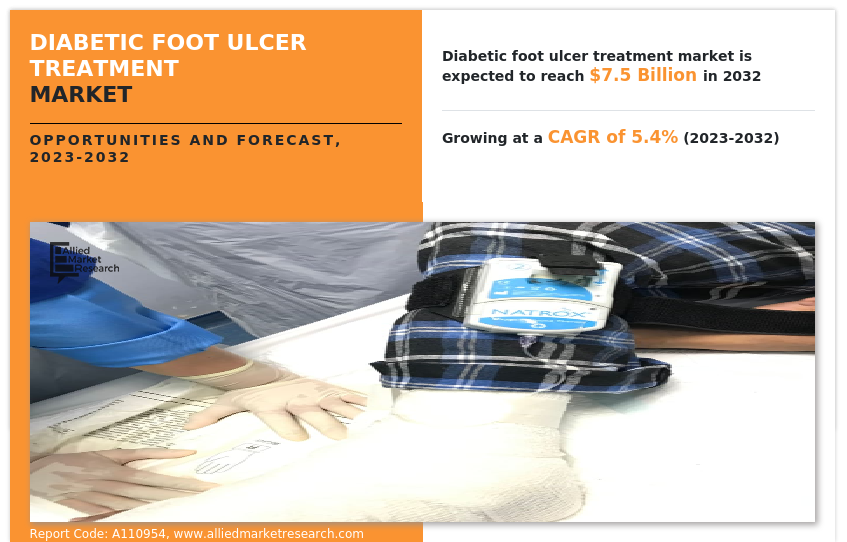
Market Dynamics
The major factors driving the growth of the diabetic foot ulcer treatment market are increase in prevalence of diabetes, rise in geriatric population, and rise in technological advancements in wound care management products. The rising global prevalence of diabetes is a significant driver for the market. For instance, as per National Diabetes Statistics Report by Centers for Disease Control and Prevention (CDC) in 2022, 130 million adults are living with diabetes or prediabetes in the U.S. As the prevalence of diabetes continues to rise, there is a corresponding increase in the demand for effective diabetic foot ulcer treatment options.
In addition, an aging population is another driver for the diabetic foot ulcer treatment market. With advancing age, individuals are greater at risk of developing continual conditions which include diabetes, peripheral neuropathy and peripheral arterial disorder, which increase the chance of foot ulcers. The growing range of aged people drives the demand for novel treatment options for diabetic foot ulcers. Further, advancements in wound care technologies have revolutionized the management of diabetic foot ulcers. Innovations in dressings, bioactive materials, negative pressure wound therapy (NPWT), and hyperbaric oxygen therapy (HBOT) have improved healing outcomes and accelerated wound closure. These technological advancements attract healthcare providers and patients, contributing to the growth of the market.
In addition, bioactive materials consisting of growth factors, extracellular matrices, and tissue-engineered products have proven promising effects in promoting wound recovery and tissue regeneration. Further, these substances can stimulate cellular sports, accelerate angiogenesis, and can lead to formation of new tissue. Thus, they're regularly used as adjunctive therapies to accelerate the restoration of diabetic foot ulcers.
Moreover, adoption of multidisciplinary approach in diabetic foot ulcer control has driven the market growth. This approach involves collaboration amongst diverse healthcare professionals, such as podiatrists, vascular surgeons, wound care specialists, endocrinologists, and infectious disease professionals. Moreover, government initiatives and support play a significant role in driving the diabetic foot ulcer treatment market. Governments and healthcare organizations across the globe are implementing programs to promote foot care education, establish specialized diabetic foot clinics, improve access to healthcare services, and enhance reimbursement policies for diabetic foot ulcer treatment. These initiatives aim to reduce the burden of foot ulcers and associated complications.
Various organizations along with the government are counselling people regarding diabetes and available treatment options. E-commerce (electronic commerce) has become a vital tool for small and large businesses globally, owing to a rise in preference of consumers for online shopping over traditional purchasing methods. Various animations through health apps to educate people regarding diabetic foot ulcer and usage of wound care devices have contributed toward the diabetic foot ulcer treatment market growth.
However, reimbursement policies may not adequately cover the costs of diabetic foot ulcer treatment, leading to challenges in accessing and affording necessary interventions. Limited insurance coverage or inadequate reimbursement rates for wound care products, devices, and procedures can impact treatment options and patient outcomes. Improved reimbursement policies and expanded coverage could alleviate this restraint.
The outbreak of COVID-19 has disrupted workflows in the health care sector around the world. The pandemic led to disruptions in healthcare services, including the management of diabetic foot ulcers. Lockdowns, restrictions on non-essential healthcare visits, and overwhelmed healthcare systems affected the availability and accessibility of diabetic foot ulcer treatments. Many elective procedures and non-emergency appointments were postponed or canceled, leading to delayed or inadequate care for individuals with diabetic foot ulcers. The pandemic caused disruptions in the global supply chain, including the production and distribution of wound care products, dressings, and devices used in diabetic foot ulcer treatment. This resulted in shortages and challenges in accessing essential wound care supplies, affecting the ability of healthcare providers to deliver optimal care to diabetic foot ulcer patients. Thus, COVID-19 negatively impacted the growth of diabetic foot ulcer treatment market.
However, as healthcare systems regain stability, efforts to recover and resume non-urgent medical services, including diabetic foot ulcer screenings, diagnosis, and treatments are anticipated to drive the market growth. This recovery phase is expected to lead to an increased demand for diabetic foot ulcer treatment options as the backlog of postponed diagnosis procedures is addressed. Healthcare providers will focus on ensuring timely access to care and treatment to mitigate the impact of delayed diagnoses and treatment initiation.
In addition, efforts to promote diabetic foot ulcer screenings and awareness campaigns are expected to drive the market growth. Governments, healthcare organizations, and advocacy groups may invest in initiatives to encourage individuals to undergo regular checkups, leading to earlier detection of diabetic foot ulcer cases. This emphasis on early detection will contribute to an increased demand for diabetic foot ulcer treatment market opportunity.
Segmental Overview
The global diabetic foot ulcer treatment industry is segmented into product, type, end user, and region. On the basis of product, the market is categorized into wound care dressings, wound care devices, biologics, and others. Based on type, the market is categorized into neuropathic ulcers, ischemic ulcers, and neuroischemic ulcers. As per end user, the market is segregated into hospitals, homecare settings, and others. Region wise, the market is analyzed across North America (the U.S., Canada, and Mexico), Europe (Germany, France, the UK, Italy, Spain, and rest of Europe), Asia-Pacific (Japan, China, Australia, India, South Korea, and rest of Asia-Pacific), and LAMEA (Brazil, South Africa, Saudi Arabia, and rest of LAMEA).
By Product
The wound care dressings segment accounted for largest diabetic foot ulcer treatment market share in 2022, owing to rise in number of key players offering advanced wound care management products, rise in regulatory approvals, and growing awareness about wound care dressings in diabetic foot ulcer treatment. The wound care devices segment is anticipated to witness highest CAGR during the forecast period owing to rising adoption of wound care devices, ongoing advancements in the field of wound care devices, and the proven effectiveness of these devices in promoting faster wound healing.
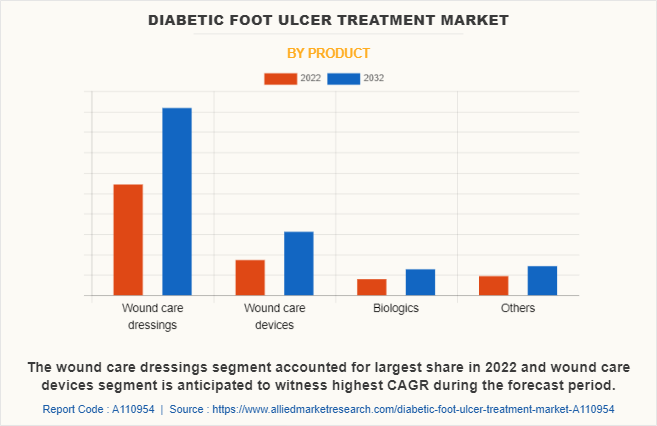
By Type
The neuroischemic ulcers accounted for largest diabetic foot ulcer treatment market share in 2022, and is anticipated to register highest CAGR during forecast period, owing to increasing prevalence of neuroischemic ulcer type in diabetic population.
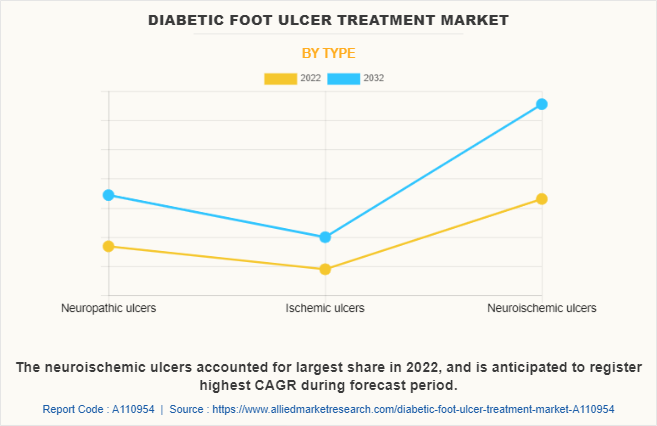
By End User
The homecare settings segment accounted for largest diabetic foot ulcer treatment market size in 2022, is projected to register highest CAGR during forecast period, owing to shift in diabetic foot ulcer treatment to homecare settings and adoption of telemedicine and remote care technologies. In addition, many individuals with diabetic foot ulcers receive ongoing care and treatment at home, facilitated by healthcare professionals or caregivers, and also provide convenience and comfort for patients while reducing the burden on healthcare facilities.
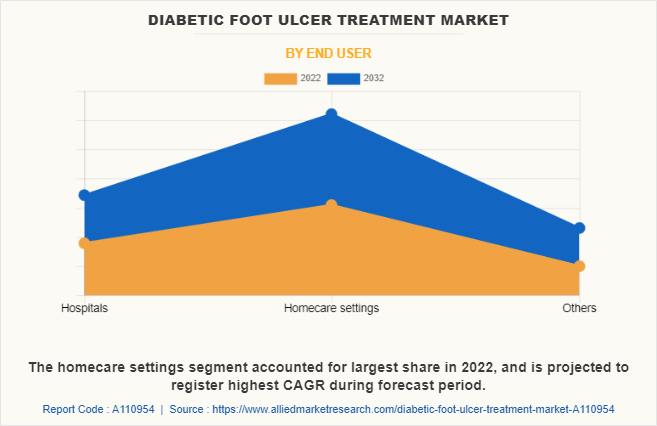
By Region
The diabetic foot ulcer treatment industry is analyzed across North America, Europe, Asia-Pacific, and LAMEA. North America accounted for largest share in terms of revenue in 2022. This growth is attributed to factors such as rise in prevalence of diabetic foot ulcers, availability of well-developed healthcare infrastructure such as specialized wound care centers & diabetic clinics, and growing emphasis on early detection & comprehensive management of diabetic foot ulcers.
Moreover, North American healthcare system has made significant investments in improving healthcare infrastructure and facilities, which has enabled better access to healthcare services and treatments for patients with diabetes. However, Asia-Pacific is expected to witness highest growth during the diabetic foot ulcer treatment market forecast period, owing to rising prevalence of diabetes, increasing healthcare expenditure, and growing awareness about the importance of early detection and treatment of diabetic foot ulcer. These factors are expected to boost the market growth.
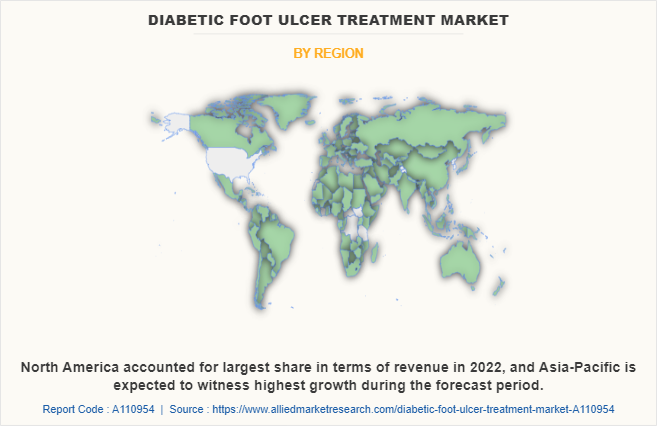
Presence of several major players, such as ConvaTec Group plc, 3M Company, Cardinal Health Inc., B. Braun SE, Integra LifeSciences Holdings Corporation, and advancement in manufacturing technology for development of effective treatment options for diabetic foot ulcer in the region are expected to drive the growth of the diabetic foot ulcer treatment market. In addition, various private organizations organize educating camps for awareness of diabetic foot ulcer and treatment options available across the globe which is expected to drive growth of the market. Furthermore, the presence of well-established healthcare infrastructure and rise in adoption rate of new treatment options, such as offloading devices, negative pressure wound therapy (NPWT), and electrical stimulation devices for diabetic foot ulcer, are expected to drive the market growth.
Asia-Pacific is anticipated to grow at the fastest rate during the forecast period. The market growth in this region is attributable to the presence of key players in the region. The Asia-Pacific region has made significant efforts in improving its healthcare infrastructure, including diabetic foot care facilities and specialized foot care centers. The establishment of comprehensive wound care centers, advancements in diagnostic technologies, and access to modern treatment modalities drive the diabetic foot ulcer treatment market.
Asia-Pacific offers profitable opportunities for key players operating in the diabetic foot ulcer treatment market, thereby registering the fastest growth rate during the forecast period, owing to the growth in infrastructure of industries, rise in spending for wound care research, as well as well-established presence of domestic companies in the region. In addition, the rise in contract manufacturing organizations within the region provides great opportunity for new entrants in this region.
Competition Analysis
Competition analysis and profiles of the major players in the diabetic foot ulcer treatment market, such as ConvaTec Group plc, 3M Company, Cardinal Health Inc., Organogenesis Holdings Inc., Smith and Nephew plc., B. Braun SE, Coloplast, Integra LifeSciences Holdings Corporation, Molnlycke Health Care AB, and Essity Aktiebolag AB, are provided in the report. Major players have adopted acquisition, contract, product launch, and product approval as key developmental strategies to improve the product portfolio of the market.
Recent Product Approval in Diabetic Foot Ulcer Treatment Market
In August 2022, Organogenesis, a leading regenerative medicine company, announced that it has received U.S., Food and Drug Administration (FDA) 510k Clearance for PuraPly MZ, a brand extension to the PuraPly product portfolio. PuraPly MZ leverages the innovative properties of PuraPly technology engineered into a micronized (powdered) form to provide surgeons with an option for complex surgical wounds.
Recent Product Launch in Diabetic Foot Ulcer Treatment Market
In June 2021, Convatec launched Chlorasolv in Europe, a gentle wound debrider efficient against biofilm, within the recognized wound hygiene protocol care, designed to accelerate healing in hard-to-heal wounds.
Recent Acquisition in Diabetic Foot Ulcer Treatment Market
In December 2021, Essity acquired U.S.-based advanced wound care company, Hydrofera, developer of Blue Antibacterial Wound Dressings, an advanced line of wound care products designed to shorten healing times, lower treatment costs, and deliver better patient outcomes.
Key Benefits for Stakeholders
- This report provides a quantitative analysis of the market segments, current trends, estimations, and dynamics of the diabetic foot ulcer treatment market analysis from 2022 to 2032 to identify the prevailing diabetic foot ulcer treatment market opportunities.
- The market research is offered along with information related to key drivers, restraints, and opportunities.
- Porter's five forces analysis highlights the potency of buyers and suppliers to enable stakeholders make profit-oriented business decisions and strengthen their supplier-buyer network.
- In-depth analysis of the diabetic foot ulcer treatment market segmentation assists to determine the prevailing market opportunities.
- Major countries in each region are mapped according to their revenue contribution to the global market.
- Market player positioning facilitates benchmarking and provides a clear understanding of the present position of the market players.
- The report includes the analysis of the regional as well as global diabetic foot ulcer treatment market trends, key players, market segments, application areas, and market growth strategies.
Diabetic Foot Ulcer Treatment Market Report Highlights
| Aspects | Details |
| Market Size By 2032 | USD 7.5 billion |
| Growth Rate | CAGR of 5.4% |
| Forecast period | 2022 - 2032 |
| Report Pages | 296 |
| By Product |
|
| By Type |
|
| By End user |
|
| By Region |
|
| Key Market Players | 3M Company, Essity Aktiebolag AB, Cardinal Health Inc., B. Braun SE, Coloplast, ORGANOGENESIS HOLDINGS INC., Smith and Nephew plc., ConvaTec Group plc, Molnlycke Health Care AB, Integra LifeSciences Holdings Corporation |
Analyst Review
This section provides various opinions in the global diabetic foot ulcer treatment market. The global diabetic foot ulcer treatment market is expected to growowing to increase in demand for novel therapeutics and rise in investments for developing advanced wound care dressings globally are expected to offer profitable opportunities for the expansion of the market. In addition, favorable government initiatives and rising awareness about available treatment options, has piqued the interest of several companies to develop novel treatments for diabetic foot ulcer.
Further, growing diabetic patient population, focus on preventive care measures, and importance of multidisciplinary care for diabetic foot ulcer treatment are the factors expected to boost the growth of market. In addition, management of diabetic foot ulcers often requires a multidisciplinary approach involving various healthcare professionals, including podiatrists, endocrinologists, wound care specialists, vascular surgeons, and infectious disease specialists. The increasing prevalence of diabetic foot ulcers has led to the expansion of specialized foot care services, such as diabetic foot clinics and wound care centers. These dedicated healthcare facilities provide comprehensive care for individuals with diabetic foot ulcers, encompassing assessment, treatment, prevention, and patient education.
Furthermore, North America accounted for largest share in terms of revenue in 2022. This growth is attributed to factors such as rise in prevalence of diabetic foot ulcers, availability of well-developed healthcare infrastructure such as specialized wound care centers & diabetic clinics and growing emphasis on early detection & comprehensive management of diabetic foot ulcers. However, Asia-Pacific is expected to witness highest growth during the forecast period, owing to rising prevalence of diabetes, increasing healthcare expenditure, and increasing awareness about the importance of early detection and treatment of diabetic foot ulcer. These factors are also expected to boost the market growth.
The total market value of diabetic foot ulcer treatment market is $4,433.54 million in 2022.
The forecast period for diabetic foot ulcer treatment market is 2023 to 2032.
The market value of diabetic foot ulcer treatment market in 2032 is $7,483.08 million.
The base year is 2022 in diabetic foot ulcer treatment market.
Top companies such as ConvaTec Group plc, 3M Company, Cardinal Health Inc., Smith and Nephew plc., B. Braun SE, Coloplast held a high market position in 2022. These key players held a high market position owing to the strong geographical foothold in North America, Europe, Asia-Pacific, and LAMEA.
The wound care dressings segment is the most influencing segment in diabetic foot ulcer treatment market owing to rise in number of key players offering advanced wound care dressings, rise in regulatory approvals, and growing awareness about wound care dressings in diabetic foot ulcer treatment.
The major factor that fuels the growth of the diabetic foot ulcer treatment market are increasing prevalence of diabetes, growing number of diabetic foot ulcer cases, advancements in medical technology, and the emphasis on early detection and comprehensive management.
Diabetic foot ulcers are chronic wounds that develop on the feet of individuals with diabetes. They are a common and serious complication of diabetes mellitus, resulting from a combination of factors, including peripheral neuropathy (nerve damage) and peripheral arterial disease (poor blood circulation).
The management of diabetic foot ulcers requires a comprehensive approach that includes wound care dressings & devices, off-loading techniques, infection control and addressing underlying factors contributing to the ulcer's development.
Loading Table Of Content...
Loading Research Methodology...



